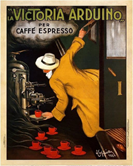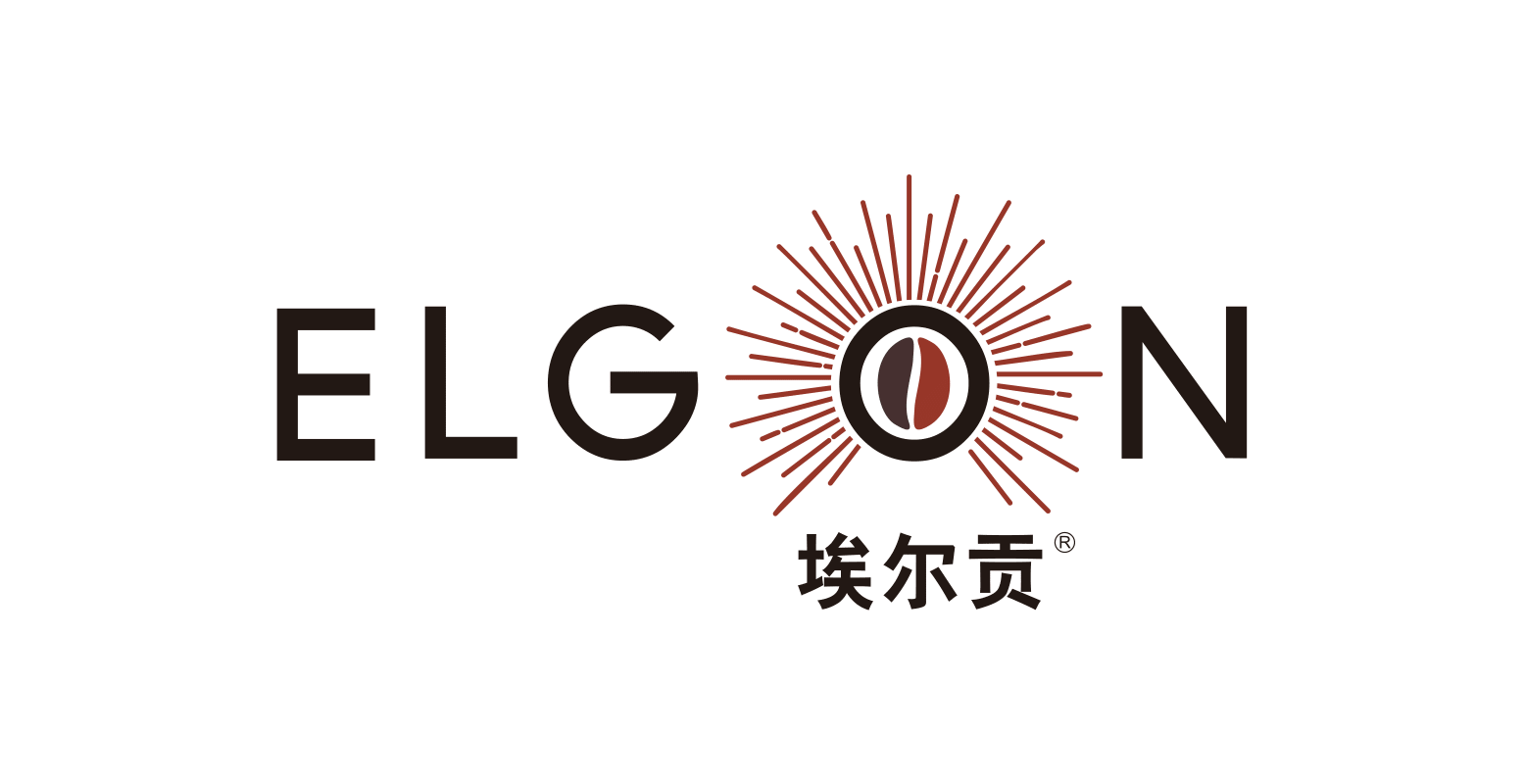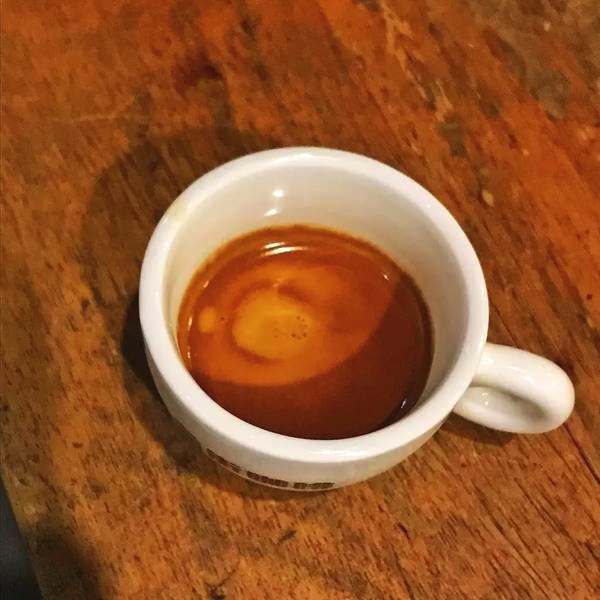This post contains affiliate links to products. Please assume all such links are affiliate links which may result in SoloEspresso earning commissions and fees at no additional cost for you.
这篇文章包含产品的附属链接。请假设所有这些链接都是附属链接,可能导致SoloEspresso赚取佣金和费用,但不会为您增加任何费用
The history of Espresso is unique.
意式浓缩咖啡的历史是独一无二的。
You might expect it to be about coffee beans, the search for the perfect flavor or about the exact science (or art) that makes pouring an exquisite demitasse of espresso possible.
你可能希望它是关于咖啡豆的,关于寻找完美味道的,或者是关于如何做出一杯精致的意式浓缩咖啡的精确科学(或艺术)。
But the story isn't like that at all.
其实故事不是这样的。
Instead, the history of the espresso coffee is about locality, about a generation of people and about inventions.
正相反,意式浓缩咖啡的历史是关于地域、一代人和发明的历史。
It's a bit like espresso itself. You'll just have to taste it for yourself.
这有点像意式浓缩咖啡本身,你得自己品尝。
The Place Was Italy,事情发生在意大利
If you wanted to hatch a political revolution... rehash a local sports event... air your perspectives on the meaning of life... or just put another taxing day at work behind you... the public coffeehouse was the place to go.
如果你想策划一场政治革命…讨论当地举办的体育赛事…说出你对生命意义的看法…或者干脆把明天的繁重工作抛在脑后…公共咖啡馆是个好去处。
When you stepped inside the door, you saw men relaxing together, sitting around the bar, fraternizing with steaming coffee mugs in hand.
当你走进门时,你会看到男人们一起,轻松地围坐在酒吧里,手里端着热气腾腾的咖啡杯,友好地交谈。
In the late 1800's in Italy, coffee was often a guy thing. It was about relationships. It was about a place to go. In Italy, coffee was a bridge to unite.
在19世纪后期的意大利,咖啡通常是男人的专利。它是维系人们之间关系的媒介。咖啡馆是一个适合去的地方。在意大利,咖啡是人们交往的桥梁。
The Time Was the Age of Steam,那正是蒸汽机时代
The world was rushing, fireboxes ablaze with the passion for invention, into the era of speed.
世界在飞速前进,充满发明激情的火药桶在燃烧,进入了速度的时代。
Everything had to be faster, more efficient, more mechanized.
一切都必须更快、更有效率、更机械化。
Coffee was no different.
咖啡也一样。
Espresso was not originally brewed for taste nor quality. It was not about the crema nor the concentration (both accidental side effects of the espresso revolution).
意式浓缩咖啡最初并不是为了味道和质量而发明的。它既不是关于油脂沫(crema),也不是浓度(两者都是浓缩咖啡革命的意外副产品)。
It was about serving coffee faster, "express."
它是为了更快地提供咖啡,“快速”。
The Thing Was the Machine,关键在于机器
Steam engines drove locomotives, ultimate symbols of the newborn power and speed of the day.
蒸汽机驱动着机车,这是当时新生力量和速度的终极象征。
Caffeine-powered coffee harmonized with the accelerated mood of the hour. Men wanted a fast machine to deliver their coffee, too. Preferably a steam machine.
咖啡中所含的咖啡因可以给人们带来了一小时内的轻松和激情。男人们也想要一台能快速做出咖啡的机器,最好是蒸汽机。
Espresso is all about the machine.
意式浓缩咖啡完全仰仗着机器。
That's why the term "stovetop espresso" is technically incorrect. Espresso doesn't require a particular coffee bean.
这就是为什么术语“stovetop espresso”从技术的角度来说是错误的。浓缩咖啡不需要特别的咖啡豆。
It isn't really defined by the flavor or the presentation. True espresso comes only from an espresso machine.
意式浓缩咖啡并不是由味道或外观来定义的[i]。真正的浓缩咖啡只来自浓缩咖啡机。
The Man Was Angelo Moriondo – 1884
发明人是安吉洛·莫里翁多,1884年
In Turin, Italy, in 1884, a patent was granted for a steam-powered machine that would produce coffee.
1884年,在意大利的都灵,有人成功注册了一项用于制作咖啡的蒸汽动力机器的专利。
Angelo Moriondo had visualized a big boiler that would force water through coffee grounds at 1.5 bars of pressure (1.5 times the amount of pressure naturally exerted by earth's atmosphere) in order to quickly prepare large quantities of coffee.
安吉洛·莫里翁多(Angelo Moriondo)曾设想过一个大型锅炉,可以让水以1.5巴的压力(1.5倍于地球大气压)通过咖啡粉,从而快速地煮出大量的咖啡。
Yet another boiler was required for the machine to generate steam to finish brewing up the mechanized coffee.
这台机器还需要另一个锅炉来产生蒸汽,以完成机械化冲泡咖啡。
Moriondo invented this new machine for the Turin General Exposition, a World's Fair focused on industry.
莫里翁多先生(Moriondo)为都灵博览会发明了这台新机器,都灵博览会是一个关注工业发展的世界博览会
The big coffee machine was quick and economical. At the World's Fair in 1896, one steam machine churned out 3,000 cups of coffee every single hour.
这个大咖啡机又快又经济。在1896年的世界博览会上,这样一台蒸汽咖啡机每小时能制作出来3000杯咖啡[ii]。
The taste? Not so good.
味道嘛,就不太好了。

The high temperatures at which the coffee was brewed in the newfangled machine produced a very bitter, almost burnt beverage.
新发明的这个咖啡机在高温下煮出来的咖啡味很苦,几乎是焦糊的。
The Reason Was Efficiency – 1901,理由是效率,1901年
Luigi Bezzera, a manufacturer from Milan, Italy, envisioned a machine that could quickly dispense coffee in more practical quantities.
意大利米兰的制造商,Luigi Bezzera,设想了一种可以快速分发更多数量咖啡的机器。
On coffee break in the factories, men would wait leisurely for their coffee to brew before drinking it and going back to work.
在工厂休息时间,男人们会悠闲地等着煮好咖啡,喝完咖啡然后再回去工作。
Factory bosses naturally wanted to speed the whole process up. Bezzera constructed the answer.
工厂老板们自然希望工人们尽快开始工作,Bezzera给出了答案。
Bezzera's machine, patented in 1901, also included a boiler that forced hot water through coffee grounds.
1901年获得专利的Bezzera的咖啡机还包括一个锅炉,可以将热水注入咖啡粉层中。
However, Bezzera added portafilters, baskets into which the coffee grounds could be carefully tamped to regulate the pressure and consistency at which the water would be forced through the grounds.
然而,Bezzera的机器增加了手柄和粉碗,精心调整粉碗里的咖啡粉,有助于调节压力[iii]和均匀度,压力迫使热水穿过咖啡粉层挤出来。
These portafilters were clamped onto groupheads in the machine. Both groupheads and portafilters characterize modern espresso machines today.
咖啡制作手柄被夹在机器的冲泡头上。这里的冲泡头(grouphead)和手柄(portafilter)都是现代意式浓缩咖啡机的标志。
The temperatures in Bezzera's machine were lowered as they passed through the various mechanisms of his machine, alleviating the burnt, bitter taste.
热水通过Bezzera机器的各个通路时,热水的温度降低了,因此避免了烧焦的苦味。
In only 30 seconds, hot coffee gushed from the machine straight into the workman's cup.
只需30秒,热咖啡就从咖啡机里流出来,直接流到工人的咖啡杯里。
The next guy in line for a cup of coffee from one of Bezzera's machines might not receive quite the same quality of coffee as the man before him.
排队买咖啡的人里下一个人从Bezzera的机器上拿到的咖啡质量可能不如他前面那一个人的咖啡更好。
However, since temperatures and pressures inside the machine varied with the changing intensity of the flame that heated it.
然而,机器内部的温度和压力会随着加热的火焰强度的变化而变化。
The Method Was Ideale – 1905,这是理想的方法,1905年
Bezzera did not have the necessary money or skill for marketing his product.
贝泽拉(Bezzera)没有推销他的产品必要的资金和技术。
Desiderio Pavoni had both, along with some inventive capabilities of his own.
德西德里奥·帕沃尼(Desiderio Pavoni)既有资金和技术,也有他自己的一些创新能力。

In 1905, Desiderio Pavoni purchased the patent for Bezzera's steam-powered coffee maker and put it on the market.
1905年,Desiderio Pavoni购买了贝泽拉(Bezzera)公司蒸汽咖啡机的专利,并将其推向市场。
Pavoni's enhanced machine flaunted both a pressure release valve and a steam wand. Named the Ideale, the new espresso machine debuted at the Milan Fair in 1906 and was produced at a rate of one a day from a small workshop in Milan.
帕沃尼的增强型机器炫耀着一个压力释放阀和一个蒸汽棒。这款咖啡机名为Ideale,于1906年在米兰博览会上首次亮相,每天从米兰的一个小作坊里生产一台。
As use of the new machine gained prevalence, fondness for the distinctive "espresso" coffee that it produced grew as well.
随着新机器的普及,人们对它生产的独特的“espresso”咖啡的喜爱也与日俱增。
Yet espresso had not yet truly come into its own as a unique brew.
然而到此时,浓缩咖啡还没有真正成为一种独特的饮品。
The 1.5 bars of pressure that a steam-powered machine could produce formulated a coffee that fell far short of the concentration and potent taste of a demitasse of espresso today.
一台蒸汽驱动的机器所能产生的1.5巴的压力,只能做出一种远不如今天的意式浓缩咖啡浓度高、味道浓郁的咖啡。
Espresso in the early 1900's was not really much different than a regularly percolated cup of coffee.
在20世纪初,浓缩咖啡和普通的滴滤咖啡还没有什么不同。
The Word Was Espresso – 1920,这种咖啡叫做espresso,1920
Alfredo Panzini, a writer from Senigallia, Italy, published the first dictionary to include the word espresso as a coffee around 1920.
来自意大利塞尼加利亚的作家阿尔弗雷多·潘西尼(Alfredo Panzini)在1920年左右出版了第一本将espresso(意式浓缩咖啡)一词收入条目的词典。
It was defined as "caffé espresso, made using a pressurized machine or a filter, now commonplace."
这个单词被定义为“用加压机器或过滤器制作的浓缩咖啡”,现在很常见。
The Feeling Was True Love – 1922,敢情是真爱,1922
Pier Arduino from Turin, Italy, realized the inadequacy of using steam to power coffee makers, but he simply couldn't generate any solutions.
来自意大利都灵的Pier Arduino意识到了用蒸汽来驱动咖啡机的不足之处,但他就是想不出任何解决方案。

In spite of blueprints and even patents, Arduino's potential inventions just didn't work.
尽管有设计蓝图,甚至有专利,Arduino先生潜在的发明就是行不通。
Nonetheless, Arduino's failures in engineering didn't put a damper on his ardent love for espresso machines.
尽管如此,Arduino在工程上的失败并没有影响他对咖啡机的热爱。
He sold them in Paris and exported them around the world.
他在巴黎销售这个机器,还出口到世界各地。
To advertise the machines, he hired an Italian artist named Leonetto Cappiello.
为了给这些机器做广告,他聘请了一位名叫列奥内托·卡皮耶洛的意大利艺术家。
A man in a yellow coat hangs from the open door of a rushing, steam-powered train.
一名身穿黄色外套的男子悬挂在一列火车的列车上。
He's reaching out to draw a hot cup of coffee, fresh from an espresso machine.
他伸手去拿一杯刚从咖啡机里做好的热咖啡。
Cappiello's 1922 advertising poster is still iconic.
卡皮耶洛1922年做的这个广告海报至今仍然具有标志性。
Steam-powered speed. The essence of the first espresso.
蒸汽速度,浓缩咖啡的精华
The Shot Was Perfected – 1947,1947年蜕变成蝶
What Arduino could not accomplish, Achille Gaggia found a way to attain in 1947.
Arduino没有做到的事情,阿奇列·加吉亚(Achille Gaggia)在1947年找到了实现的方法。
Gaggia's iteration of the espresso machine was still essentially powered by steam.
加吉亚(Gaggia)的浓缩咖啡机基本上还是由蒸汽驱动。
However, water was forced through the coffee grounds at dramatically heightened pressures through the addition of hand-pumped spring-pistons.
然而,通过添加手动的弹簧活塞,在很高的压力下强行把水压过咖啡粉层。
Steam boilers were smaller on Gaggia's machines. Yet with the use of the hand levers, an increased eight to ten bars of pressure (eight to ten times the amount of pressure naturally exerted by earth's atmosphere) spurted through the grounds.
在Gaggia的机器上,蒸汽锅炉要小一些。然而,由于手动控制杆的作用,粉层上获得的压力达到了8到10巴(是地球海平面大气压力的8到10倍)。
Achille Gaggia's high-pressure machines extracted even the essential, soluble oils from the finely ground coffee beans, leaving a frothy foam on the top of every cup.
阿奇列·加吉亚(Achille Gaggia)的高压咖啡机甚至能从研磨得很细的咖啡豆中提取出可溶性油脂,在每杯咖啡的表面留下泡沫。
This unusual floating layer was not necessarily an advantage – it looked like scum, after all. Gaggia embraced it, named it, marketed it, popularized it.
这种不寻常的泡沫并不一定是一种优势 - 毕竟它看起来像浮渣。但是Gaggia接受了它,然后给它命名,宣传它,推广它。
Nearly three quarters of a century later, avid coffee enthusiasts still look for the "crema" as the badge of a perfectly brewed cup of espresso.
将近四分之三世纪过去了,狂热的咖啡爱好者仍然将“crema”视为一杯完美制作的意式浓缩咖啡的标志。
Crema was not the only classic feature bequeathed to the espresso by Gaggia's machines.
这种咖啡表面的油脂沫并不是加吉亚的咖啡机做的浓缩咖啡的唯一特征。
In order for the hand-pumped levers to operate properly, the cylinders on the new machines were limited to holding only a single ounce of water.
为了使手动控制杆正常工作,新机器上的气缸只能装一盎司水[iv]。
The tiny "shot" of espresso that poured out of the machines was highly concentrated. Drank straight, the flavor was something new – bold, potent.
从咖啡机里倒出来的一小杯浓缩咖啡是高度浓缩的。直接喝下去,有一种全新的味道 – 浓郁而厚重。
Concentrated into one ounce of liquid, velvety and rich, crowned with a foamy crema, espresso had come into its own at last.
浓缩成一盎司的液体,口感绵密而醇厚,上面有一层泡沫状的奶油,浓缩咖啡最终形成了自己特定的风格。
The Innovation Was Universal – 1961,这一创新是普世的,1961
The next celebrity of espresso was the Faema E61. Ernesto Valente, head of the Faema company, wanted to make espresso machines accessible even to small cafés and coffeehouses. The first step was to make espresso makers more affordable, but that was not the only conspicuous improvement of the Faema E61. The Faema E61 was semi-automatic, eliminating the need for Gaggia's hand-pumped levers. Instead, a motor in the Faema E61 pumped water through a spiral copper pipe inside the boiler, heating the water to a perfect brewing temperature before forcing it through the coffee grounds at exactly nine bars of pressure. The result was a consistent, easily achieved espresso – but that wasn't all. Gaggia's espresso machines were large, vertical constructions, but the Faema E61 was a smaller, stainless steel, horizontal machine. Easier to operate, cheaper, smaller, Faema E61's suddenly appeared everywhere in Italy. They were at home in Italian coffeehouses where the climate was all about socializing together over affordable, iconic cups of coffee.
浓缩咖啡的下一个名人是费马公司(Faema)的 E61咖啡机。费马公司的老板埃内斯托·瓦伦特(Ernesto Valente)想要让浓缩咖啡机在小型咖啡馆也能用上。第一步是让咖啡机更便宜,但这并不是Faema E61的唯一显著改进。Faema E61是半自动的,不需要Gaggia那样的手动控制杆。相反,Faema E61的一个马达通过锅炉内的一个螺旋铜管将水抽上来,将水加热到一个合适的温度,然后在正好9巴[v]的压力下强迫它通过咖啡粉层。结果就可以稳定而轻松地做出意式浓缩咖啡。但这还不是全部。加吉亚咖啡机很大,还是竖直结构的;而Faema E61咖啡机就很小,而且是不锈钢外壳的水平结构的咖啡机。操作简单、便宜、体积小这些特点让Faema E61咖啡机突然就遍布了意大利各地。意大利人聚集在咖啡馆里,一起喝着便宜的、独特的咖啡,构成了意大利特有的社交活动。
The Convenience Was Home – 1970,家庭的便利,1970
In the late 1970's, a company named Ulka produced the first espresso machines truly suited for home use.
20世纪70年代末,一家名为Ulka的公司[vi]生产出了第一台真正适合家庭使用的浓缩咖啡机。
Finally, the espresso machine was small enough, affordable enough, and easy enough to operate to allow espresso to be brewed in home kitchens.
最终,意式浓缩咖啡机变得足够小、足够便宜、足够容易操作,让各个家庭都可以在厨房里自己做浓缩咖啡[vii]。
The Ulka machine was bought out by larger companies as both commercial and home-use machines were perfected and produced around the world.
随着商用和家用咖啡机的不断完善和在世界各地的生产,Ulka的咖啡机业务被大公司收购。
The Spot Was Starbucks – 1987
Before Howard Shultz purchased Starbucks in 1987, it was merely a company focused on purchasing, roasting, and selling coffee beans.
霍华德舒尔茨在1987年收购星巴克(译者注:品牌商标)之前,它只是一家专注于采购、烘焙,然后销售咖啡豆的公司。
Shultz had a different vision.
舒尔茨的想法不同。
He had visited Milan, Italy, in 1983, and there he had seen what a relationally - centered, local coffeehouse could be.
1983年,他在意大利米兰出差时,在那里他看到了一个个以人际关系为中心的当地太多的咖啡馆。
Through Starbucks, espresso reached new heights as a café experience in America, as well.
意式咖啡(译者注:在北美主要是拿铁咖啡)通过星巴克这个品牌,在美国发展到了一个新的高度。
Bigger machines were introduced with more capacities for creating the varieties of espresso-based drinks that Americans came to love.
利用更大的机器,以其更强大的能力来制作各种美国人喜爱的以意式浓缩咖啡为基础的咖啡饮料。
Although many espresso enthusiasts remember its Italian roots, espresso could no longer be defined as an Italian only drink.
尽管许多浓缩咖啡爱好者还记得它的意大利渊源,但浓缩咖啡已经不再被定义为意大利唯一的饮料了。
The Brew Was Iconic,该制作方式具有标志性的意义

When electric pump models were introduced in espresso machines, the capacity of the cylinder was no longer limited to one ounce of water as it had been with hand-pumped machines.
在咖啡机开始使用电泵之后,制作咖啡所用的水就不再像拉杆机那样限于一盎司了。
Further innovations could potentially be introduced. However, the "classic" espresso as it had been brewed in the 1950's had become legendary.
也许将来还会有更多的创新,但是20世纪50年代时的“经典”意式浓缩咖啡已经成为了传奇。
People around the world had a love affair with the concentrated, bold flavor and the distinctive crema.
世界各地的人们都喜欢这种咖啡浓郁的、醇厚的味道,和独特的油脂沫。
Espresso was no longer just coffee prepared quickly using a machine. Espresso had become a unique drink of its own, with a legacy of lore and art attending its preparation.
意式浓缩咖啡不再只是机器快速做出来的咖啡。意式浓缩咖啡已经成为一种独特的咖啡饮料,它的制作过程充满了相关的知识和艺术。
The one ounce "shot" of espresso was here to stay. Many espresso devotees approach every demitasse of espresso critically. Differences in the machines used to prepare the espresso can create subtle differences in the resulting flavor.
一盎司的浓缩咖啡就在这里。许多咖啡爱好者挑剔地对待每一杯咖啡。不同的机器用来准备浓咖啡可以创造出不同的味道。
The blend and roast of the coffee beans used will certainly produce distinctive tastes. The texture of the grind should be uniform and fine – but not too fine. Even the skill of the barista who drew(译者注:疑似brew) the coffee is critiqued in that first sip. Every individual person has slightly different ideas about what constitutes the perfect shot of espresso, influenced by their own culture, locality, and personal tastes.
咖啡豆的拼配和烘焙一定会产生独特的味道。研磨的质地应该是均匀和精细的,但也不要太细。甚至有人在喝第一口咖啡之后,就对咖啡师的制作技巧进行了批评。每个人对一杯完美的意式浓缩咖啡的构成都有些许不同的看法,受到他们自己的文化、地域和个人品味的影响。
Nonetheless, the espresso retains an identity of its own.
尽管如此,意式浓缩咖啡还是保留了自己的特色。
The Possibilities Are Endless,未来的可能性是无限的
Even if you don't appreciate the intense flavor of a pure shot of espresso, you've probably enjoyed espresso as a base for a coffee drink that you do love. Simply adding hot water or mineral water to an espresso "waters it down" to an Americano, but the possibilities certainly don't stop there. Especially in the United States, steamed milk is often added to espresso along with a long list of other potential, sweet ingredients to create an immense variety of coffee beverages.
即使你不喜欢一杯意式浓缩咖啡的浓烈味道,你也可能喜欢把浓缩咖啡作为你喜欢的咖啡饮品的基础。简单地把热水或矿泉水加到浓咖啡里,“淡化”一下就成了美式咖啡的味道,但可能性当然不止于此。特别是在美国,蒸牛奶经常和其他一长串潜在的甜的成分一起加入到浓咖啡中,创造出种类繁多的咖啡饮料。
尾注:
[i] 译者注:越说越不靠谱了,作者的理解有问题。
[ii] 译者注:因此很适合当时工厂里大批工人的需要。
[iii] 译者注:这里无意中说出了意式咖啡萃取的关键所在,但不知道他是真的明白还只是碰巧。
[iv] 译者注:这一理解应该是他个人的猜测,实际容纳的热水体积可能更大。因为流出的咖啡液的多少因粉层的密度不同而改变,并非固定地只出一盎司的咖啡液。
[v] 译者注:这是现在最流行的误解。接受它,你就几乎不太可能做好咖啡了。
[vi] 译者注:该公司现在生产家用意式咖啡机常用的震动泵(待核对)。
[vii] 译者注:不知道作者的这一说法是怎么来的。因为在意大利很少有家庭用咖啡机制作咖啡,最流行的是摩卡壶。通常只有咖啡师会在家里用咖啡机做咖啡,而且主要用的是那种“E 61”型的半专业的半自动咖啡机。





